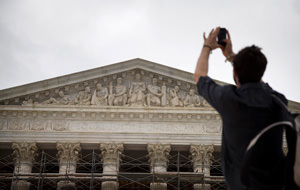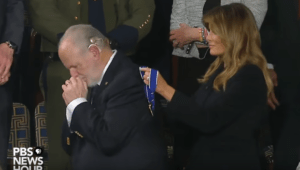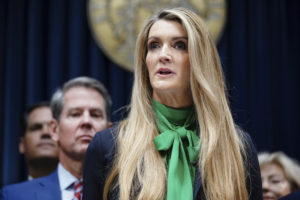The Supreme Court Could Get Even Worse This Term
If the oral arguments conducted the first two weeks of the court’s current term are any indication, the Supreme Court will drift further to the right.
Even allowing for last term’s 5-4 decisions on gay marriage or the equally narrow 2012 approval of Obamacare’s individual mandate, the Supreme Court has amassed a profoundly right-wing record under the stewardship of Chief Justice John Roberts on issues including corporate accountability, campaign finance and voting rights. And if the oral arguments conducted the first two weeks of the court’s current term are any indication, the record is likely only to harden.
It’s easy enough to analyze the court’s opinions one case at a time, identifying how each affirms or alters specific areas of law. It’s also relatively easy, as Mother Jones magazine has shown, to measure the court’s political slant statistically by adding up the number of conservative rulings issued each term or tallying the number of prior liberal court precedents the tribunal overturns.
It’s considerably harder but nonetheless critical, eight years after Roberts’ appointment, to examine the court’s record as a whole and determine whether it is more than an institution that simply produces an abundance of conservative rulings or has become a full-blown conservative agency in a committed ideological sense.
In a recent New York Review of Books blog post, Georgetown University law professor David Cole raises the question but leaves it unanswered. I think the evidence is already in and the Roberts court has crossed the ideological divide, guided by three distinct but related principles:
The Promotion of Federalism
In some of its most high-profile conservative decisions, the Roberts court has aggressively promoted a new era of federalism aimed at ending or eroding national oversight and regulation of social policy. The leading example of the new federalism is Shelby v. Holder, the horrendous decision handed down in June that gutted the Voting Rights Act. Joined by the four other Republican justices on the bench, Roberts concocted a novel constitutional doctrine in Shelby — the principle of “equal sovereignty” among the states — to justify the court’s holding that states and localities with histories of racial discrimination in elections may no longer be held to higher levels of legal scrutiny and review than those without such histories.
The court also adopted a federalist stance in 2012 when it upheld the right of states to opt out of Obamacare’s expansion of the Medicaid program, which provides health care coverage for the poor. Federalism was similarly at the heart of the questions several justices asked during this week’s oral argument in Schuette v. Coalition to Defend Affirmative Action, the latest challenge to affirmative action to come before the court.
The Court as Party Proxy
Not all of the court’s prominent right-wing decisions, however, fit a federalist ideological mold. In at least two vital constitutional spheres — campaign finance under the First Amendment, and individual gun rights under the Second Amendment — the court has blocked state regulations in favor of rigid and politically conservative uniform national standards, holding in 2010 that the constitutional right to bear arms applies directly to the states (McDonald v. Chicago) and in 2012 striking down Montana’s long-standing ban on corporate funding of state elections (American Tradition v. Bullock). The latter, in the court’s estimation, ran afoul of the infamous Citizens United opinion, which had opened the door to unlimited campaign contributions to political super PACs.
During the first week of oral arguments in the current term, the court’s five conservatives signaled their intent to augment Citizens United by invalidating the limits on campaign donations made directly to political parties (McCutcheon v. FEC).
Noting this line of cases, some court watchers stress the degree to which the Roberts court has devolved into an openly pro-Republican policy body, toeing the party line and using the law as politics by other means. Supporters of this view argue that although past Supreme Courts have ruled in favor of sitting presidents in 70 percent of the cases in which prior administrations had entered formal legal appearances, the Roberts court sided last term with the Obama administration at a historically low 37 percent rate.
The disdain of the court’s conservatives for Obama is palpable — witness the scowls of disapproval on the face of Justice Samuel Alito at the 2010 State of the Union address — and is likely to continue this term as the court considers a case on the president’s power to make appointments to federal agencies while the Senate is in recess (National Labor Relations Board v. Noel Canning).
The Promotion of the Corporate State
Although the party-proxy theory is helpful in understanding the work of the Roberts court, like the federalist model it remains incomplete as the tribunal by no means always splits along party lines, even in major cases. In two important decisions from last term, for example, the court’s four Democratic justices joined their Republican brethren to uphold Monsanto’s monopoly on the production of soybean seeds (Bowman v. Monsanto) and to remove review of human rights violations committed abroad by multinational corporations from the jurisdiction of federal courts under the Alien Tort Claims Act (Kiobel v. Royal Dutch Petroleum).
Of all the ideological principles animating the Roberts court none is more all-encompassing than the tribunal’s commitment to protecting the interests of big business and, in another departure from federalism, extending the government’s post 9/11 surveillance and security powers.
As the Washington, D.C.-based advocacy group Alliance for Justice has demonstrated in its excellent expose — The Corporate Court — the Roberts court not only has opened the floodgates to corporate money in elections but time and again has acted to shield companies from liability for defective and dangerous products (Riegel v. Medtronic Inc.), and reduce the financial risks of environmental pollution (Baker v. Exxon). The court has also made it increasingly difficult for women and exploited minorities to bring anti-discrimination class actions (Ledbetter v. Goodyear), and undermined the power of organized labor (Knox v. SEIU).
Still another study, conducted by the University of Minnesota Law Review, has found that the Roberts court’s five conservatives rank among the nine most pro-business justices in the past 65 years.
At the same time, the court has turned away challenges to the National Security Agency’s spying operations (Clapper v. Amnesty International) and paved the way for the creation of a national DNA database, upholding police practices of taking DNA samples from people who have been arrested but not convicted of any crimes, characterizing such procedures as nothing more than the 21st century equivalent of fingerprinting (Maryland v. King).
Throughout the reckless and continuing shutdown of the federal government, the Roberts court has remained the only branch of government open for business as usual. Under more ordinary circumstances, that fact would be received as unadulterated good news celebrated by all.
But these are not ordinary times. Given the court’s consolidation as an institution of right-wing ideology, most of us have little reason to cheer.
Your support matters…Independent journalism is under threat and overshadowed by heavily funded mainstream media.
You can help level the playing field. Become a member.
Your tax-deductible contribution keeps us digging beneath the headlines to give you thought-provoking, investigative reporting and analysis that unearths what's really happening- without compromise.
Give today to support our courageous, independent journalists.








You need to be a supporter to comment.
There are currently no responses to this article.
Be the first to respond.